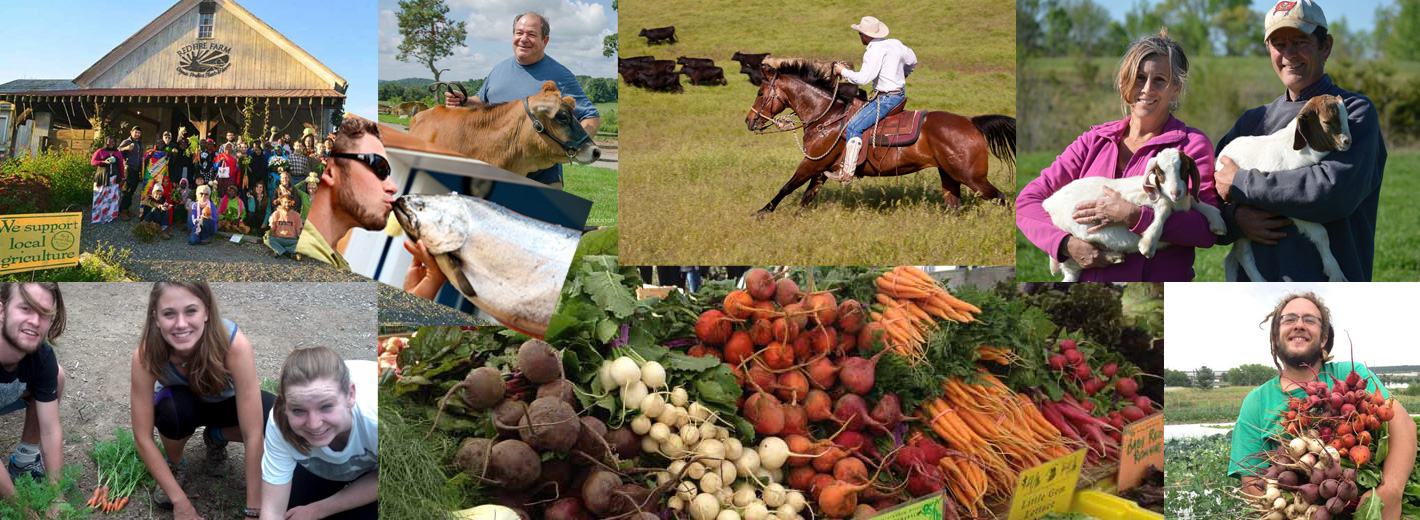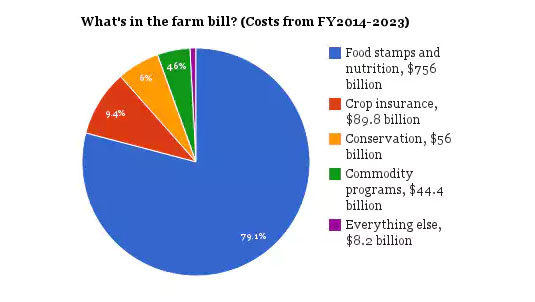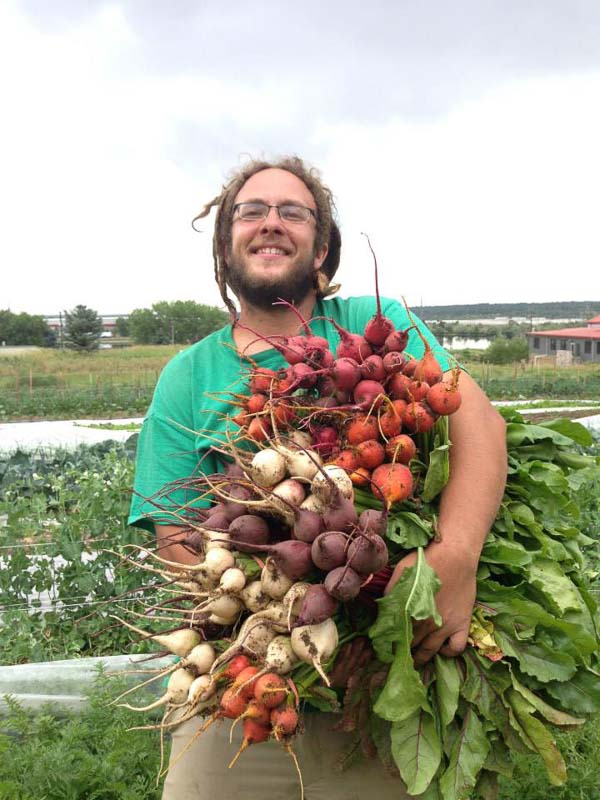
Here Comes the Farm Bill: An Introduction to Agriculture Politics
While the rest of the country focuses on the future of the Affordable Care Act, another critical debate over our nation’s public health is quietly happening in committee hearings and community gatherings across the countryside. A year from now, by September 2018, Congress will need to pass the Farm Bill.
This gargantuan piece of legislation decides the future of all things food for the next four years. As the year of Farm Bill debate approaches, it is important for everyone who wants to see food systems change to pay close attention. Due to tough times in the farm economy, politicians and farmers alike are focused on maintaining agricultural supports and passing a status quo bill, quickly.
In fact, the hearings have already begun, and opportunity for public comment has passed. The House may vote on the first Farm Bill draft as early as this fall. To help make sense of this speeding omnibus, here is a quick introduction to Farm Bill basics as well as some lesser-known sustainable agriculture policy debates to watch for in the upcoming year.
So, what’s in this thing?
To start: what is the Farm Bill and what does it cover? Every five or so years, Congress passes one large omnibus bill (aka a bill with many items) that covers the bulk of federal agriculture and food policy. It includes all affairs under the purview of the U.S. Department of Agriculture, including agricultural programs, food safety, nutrition services, and even the Forest Service.
The bill is best known for four major programs: the Supplemental Nutrition Assistance Program (SNAP, which offers nutrition assistance to millions of eligible, low-income individuals and families), crop subsidies, crop insurance, and conservation incentives. In fact these programs alone account for 99% of farm bill spending, with SNAP coming in largest at 79% of the bill.
The central thrust of this year’s Farm Bill debate will be budget cuts. In their recent budget plan, House Republicans proposed a $10 billion cut in agricultural spending over the next decade (and that is down from an original $70 billion in proposed cuts). Republicans are looking to take most of these cuts from the SNAP program, to the tune of $1 billion a year. So, one of the largest debates facing the 2018 Farm Bill will be the future of the SNAP program, which already saw an $8.7 billion cut last Farm Bill. This resulted in an average loss of $90 per month for almost 850,000 vulnerable households.
Another expected debate will be over crop insurance, and different ways to control costly insurance payouts or tailor the program to encourage more conservation farming practices. Changes in subsidies and support programs for struggling cotton and dairy industries are also anticipated.
The 1 percent
While these big-ticket talking points are certainly important and have immense power to shape our food system, protect or deplete our natural resources, and feed thousands of Americans, I cannot help but wonder, What’s being glossed over within that less than 1% of everything else? Turns out there are a lot of interesting programs packed in that tiny percentage point. Below are just a few of the lessor-known Farm Bill topics that have come up in recent committee hearings and on political action agendas.
Supporting New Farmers
For the past few decades, the overall number of farmers has decreased while the average age of farmers continues to increase. As of 2012, the average farmer was 58 years old, and many anticipate these aging farmers to retire in the coming decade. At the same time, the total number of new farms was down 20% in 2012 from 2007. In the next few years we will need new farmers to take the helm of feeding America, or risk a land grab and further consolidation and losses of farmland.
However, there has been a promising increasing in demand for local food as Americans become more interested in supporting regional food systems. This has attracted more young people to the profession, including those without agricultural backgrounds. Diversity among farmers is also increasing, bringing more equity to a farm economy in which white men run nearly 80% of all farms.
But today’s new famers face unique barriers, from access to farmland, skill building, and proper risk management to cover their smaller and more diverse operations. Government programs like the Beginning Farmer and Rancher Development Program and Rural Microentrepreneur Assistance Program received funding in the 2008 Farm Bill, and farming equity initiatives like the Section 2501 Program (officially called the Outreach and Assistance for Socially Disadvantaged Farmers and Ranchers Program) have been established since 1990, though this program faced budget cuts in the last Farm Bill. These programs provide critical grant funding for institutions and nonprofits that are working to support new and minority farmers, but they require reauthorization in every Farm Bill. All these programs are slated to end in 2018 if Congress does not reauthorize their funds in the 2018 Farm Bill.
Protecting Farm Loans
Another critical lifeline for budding farmers is access to credit. Across the board, new or established, old or young, farming requires big investments. Land, seeds, animals, and farming equipment add up fast, and most farms rely on loans, both to start their farms and to invest in costly upfront inputs at the start of each farming season. Thus, farm lending is the unrecognized backbone of the farm economy. But recent mergers in the farm lending industry may make it harder for farmers, particularly small- or medium-sized operations, to receive needed credit. There are currently federal farm loan programs that offer loans of last resort and prioritize lending to beginning, minority, women, urban, tribal, and education-oriented producers. But last summer, the USDA’s Farm Service Agency ran out of loans to give. So farmers and legislators will be especially attuned to budget allocations for farm loans this year, as any decreases could further stress an already strained credit system.
Agricultural Research Allocations
Though it might seem like a low priority, investing in the intellectual future of agricultural is critical to uncovering more sustainable ways to feed ourselves and keep farms profitable. Agricultural research will help us adapt to climate change, learn new ways to manage soil health, and breed more resilient crops.
Public agricultural research spending peaked in 1994, and has since declined by 20 percent. This decrease comes at a time when other countries like China and Brazil have ramped up their ag research; in fact, China’s agricultural budget now dwarfs U.S. spending 2 to 1. Though it might seem like a low priority, investing in the intellectual future of agricultural is critical to uncovering more sustainable ways to feed ourselves and keep farms profitable. Agricultural research will help us adapt to climate change, learn new ways to manage soil health, and breed more resilient crops.
Plus, we know that ag research also pays off. As former Acting Deputy Under Secretary for Research, Education, and Economics at the USDA Dr. Ann Bartuska said in a recent hearing, “The return on investment in agricultural research is $20 for every $1 spent.”
But we also know that ag research dollars disproportionately go to improving corn, soy, and meat production. “Specialty crops,” the funny term for all fruits, vegetables, and nuts, received just 15% of federal research dollars over the past three decades. Furthermore, programs to enhance organic research will end in 2018 if they are not explicitly reauthorized in this upcoming Farm Bill. This means there is a huge untapped potential to improve fruit, vegetable, and organic produce production through increased research.
And the new kid on the funding block: food waste
To date, food waste has not played a huge part in the Farm Bill, despite the fact that food waste volumes have been on the rise for several decades. As programs like SNAP face budget cuts, the U.S. spends $218 billion annually to grow, transport, and dispose food that will never be eaten, and this includes wasted government spending on federal crop subsidies for foods that end up in the landfill. Fortunately, the issue of food waste has drawn bipartisan interest in recent years, and the first federal effort to address food waste began in 2013, when the EPA and USDA launched the Food Waste Challenge. But if the Farm Bill’s goals are to feed people, put more money in farmers’ pockets, and conserve our natural resources, then it cannot afford to ignore the fact that 40% of food in the U.S. is wasted.
That is why ReFed, the Harvard Food Law and Policy Clinic, and Food Policy Action teamed up to create this report that identifies opportunities to reduce food waste in the 2018 Farm Bill. Some of their suggestions include; standardizing and clarifying “use by” date labels, strengthening the Bill Emerson Good Samaritan Food Donation Act (and here’s why Bon Appétit supports that), creating an office of Food Waste Reduction in the USDA, providing funds for K-12 schools to incorporate food waste education and food recovery programs, and launching a national food waste education and awareness campaign.
Conclusion
Ultimately this overview only begins to unearth a small fraction of the Farm Bill’s reach. Every day, interesting new debates pop up from forest conservation funding to peanut overproduction.
Interested in following Farm Bill more closely in the coming months? Check out free daily newsletters like Politico’s “Morning Agriculture” and food-focused news outlets like the Food and Environment Reporting Network, Civil Eats, and the University of Illinois’ Farm Policy News (formerly FarmPolicy.com).
The important thing is to stay aware and make sure you share your opinion with your representatives on any issues that speak to you.

